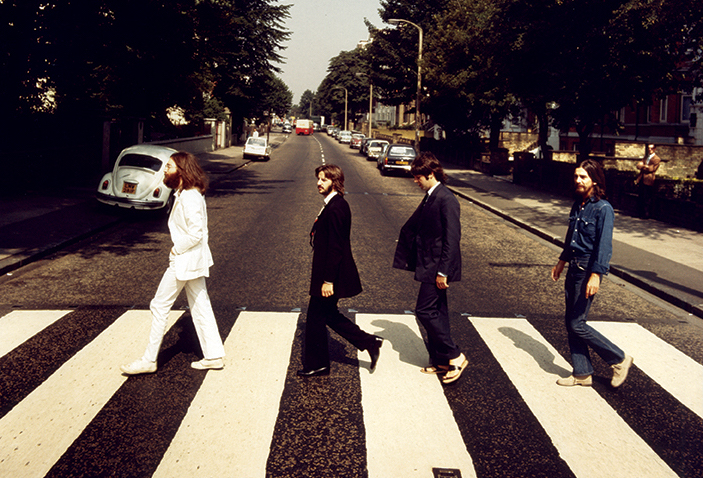The record that serves as The Beatles’ last stand, made majestic by the Fab Four’s finality, will always traffic in controversy. Did EMI’s label head lose his cool when he found out the band’s name wouldn’t be on the album cover? Were the recently discovered recordings of conversations within the band accurate—that they could’ve carried on in a vein similar to the White Album’s all-solo moments? Was Paul really dead?
That’s Abbey Road, the last album (as considered by some) of The Beatles’ career together, released on September 26, 1969 with George Martin as producer, and re-released on September 26, 2019, with George’s son Giles Martin as producer. The re-release comes with all the bells and whistles of fresh mixes in stereo, 5.1 surround, and Dolby Atmos, and expanded with previously unreleased session recordings and demos.
Stripped of its personal dramas, heightened songwriting realities, and lustrous harmonic range, Abbey Road’s first glories come in its innovations outside the band. It was the first Beatles album recorded precisely for stereo release, as well as being their sole experience with solid-state electronics, rather than aged tube technology. If you think George Martin didn’t sink his teeth into a spanking new TG 123545 mixing desk, you’re mistaken—if ever the “Fifth Beatle” title was fully realized for Martin as producer, i’s here. Kudos, too, for keyboardist Billy Preston, whose deeply soulful Hammond organ work is best heard on the album’s surprisingly edgy demos for “Oh! Darling” and “I Want You (She’s So Heavy).” Likewise, Giles Martin brings all of the record’s original mix-mastering up one notch. In particular, it is the heavenly hosanna of Abbey Road’s Side 2 suite (be it in not-that-raw demo form on its rich 2019 stereo mix). It’s like, how do you improve oxygen? Oh. That way.
The intricacies of the first Martin’s orchestrations for “Something,” “Golden Slumbers,” and “Carry That Weight” and the mood they elicit within both the simple Harrison melody and the unique framework of Lennon and McCartney’s songwriting—the theatricality of it all—are re-doubled by the later Martin in his own warm fashion. It sounds the same. And it sounds different.
Beyond the tech of Abbey Road is The Beatles’ agreement to disagreement, going into the recording process the way the foursome did in the early days, sans the boredom of union, toxic masculinity, and inner-band bitchiness. Forgetting the tension-filled times that packed their last two outings, there was a charm and lightness to their camaraderie in this case. McCartney’s demo of “Come and Get It,” a song later given to Apple labelmates Badfinger, could have come off the psychedelic Revolver album—or even earlier—as a sound-a-like B-side to “Nowhere Man.” His demo for “Goodbye” (eventually presented to Mary Hopkin) could also have gone to Rubber Soul.
It’s like, how do you improve oxygen? Oh. That way.
The idea of getting back to their beginnings as pals, however, has little to do with The Beatles’ Hamburg-to-Liverpool rock ’n’ roll roots when it comes to Abbey Road. Though John Lennon’s “I Want You (She’s So Heavy)” and “Come Together” traffic in deep ancient blues, and the set’s demos of “The Ballad of John and Yoko (Take 7)” and “Old Brown Shoe (Take 2)” wrestle with various forms of folk, there is nothing good-old-days about the airily angelic “Because,” the holy cheer of “Here Comes the Sun” (a.k.a. “The Long One,” as the medley is called here, nicknamed by the boys). No matter how many time you’ve heard the rush of “You Never Give Me Your Money” into “Sun King” into Mean Mr. Mustard” into “Polythene Pam” into “She Came in Through the Bathroom Window” into “Golden Slumbers” into “Carry That Weight” into “The End,” it sounds like a futurist’s daydream. And now, in what might be that imagined future, it still sounds like nothing else—ornate, harmonic, and clear.
Unlike with their other recordings, and for an album so mammoth as a projected final Beatles work, there isn’t a wealth of lost demos or outtakes or session takes. Yes, there’s some fun session banter included in the new collection (an early, jovial take of “The Ballad of John and Yoko” shows Lennon and McCartney joking like two old friends, doing a duet without the distraction of its other half). But it’s listening to the cutting, crafting, thinking, and re-thinking of the medley’s dreamy “You Never Give Me Your Money (Take 36),” and the skeletal run through of “The Long One” in its “Trial Edit & Mix – 30 July 1969” form, that gives you the best picture of the latter day Beatles, with Martin and Preston, pragmatically at work. Like a team of architects who came through school together, the four Beatles move diagrams and building blocks along the process of imagination, and the invisible through lines of a longtime friendship are soon to dissolve.
Long road. Great journey. FL









